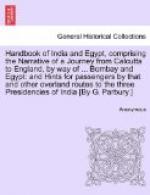From the terrace in front of the caves a fine panorama greets the eye. Below commences the wide plain which creeps northwards to the rugged hills comprising the weird couch-shaped summit of Ramsej and the solitary cone of the Chambhar Hill, embosoming the great Jain caves of the 12th century. Beyond the Chambhar cone climb heavenwards the castellated pinnacles of the Chandor range, mist-shrouded in this monsoon season. In the nearer distance the primeval Brahman settlement of Govardhan sleeps amid her mango-groves, and opposite to it the modern Christian village of Sharanpur marks the threshold of that tract of fair woodland and fairer garden which is Nasik’s pride. Here and there a red roof catches the sun’s rays and shews a splash of orange amid the green; but save for this the picture has but two tints, the warm green of the plain country in the foreground and the grey of the mighty mountain-range which stands sentinel behind it. Your feet rest upon soil hallowed by the memories of two thousand years, upon ground which bears the sign-manual of early and late Buddhist, of Jain and lastly of Maratha, who used the hill as a muster-ground of warriors and bored holes in the graven images for the tethering of his cattle and steeds. By some divine decree “the imperial banditti” kept their impious hands from the famous inscriptions which are the real glory of these caves and form the connecting-link between ourselves and that great king whose face was “as the sun-kissed lotus, whose army drank the waters of three oceans,” Shri Gautamiputra the Satakarni.
And so ends our morning’s exploration. One last visit to the silent keepers of these messages from dead monarchs—and we pass down to the high road, whence we look back once more upon Trirashmi, the casket of jewels without price, and her twin sisters gleaming in the morning light like the triple prongs of some giant Trident set there by Nature in honour of the great apostle of Humanity.
XIX.
FATEH MUHAMMAD.
We had wandered off the main thoroughfare, where the trams, hurtling past the Irani’s tea shop, drown from time to time the chatter of Khoda Behram’s clientele; and skirting a group of Mahomedans who nightly sit in solemn conclave, some on the ‘otlas,’ others on charpoys or chairs placed well in the fairway of traffic, we reached at length a sombre and narrow ‘gali,’ seemingly untenanted save by the shadows. Here a sheeted form lay prone on the roadside; there a flickering lamp disclosed through the half-open door a mother crooning to her child, while her master smoked the hubble-bubble with the clay bowl and ruminated over the events of the day,—the villainy of the landlord who contemplated the raising of the rent and the still greater rascality of the landlord’s ‘bhaya’ who insisted upon his own ‘dasturi’ as well. Here a famished cat crouched over a pile of garbage hard by the sweeper’s ‘gali’; there on




